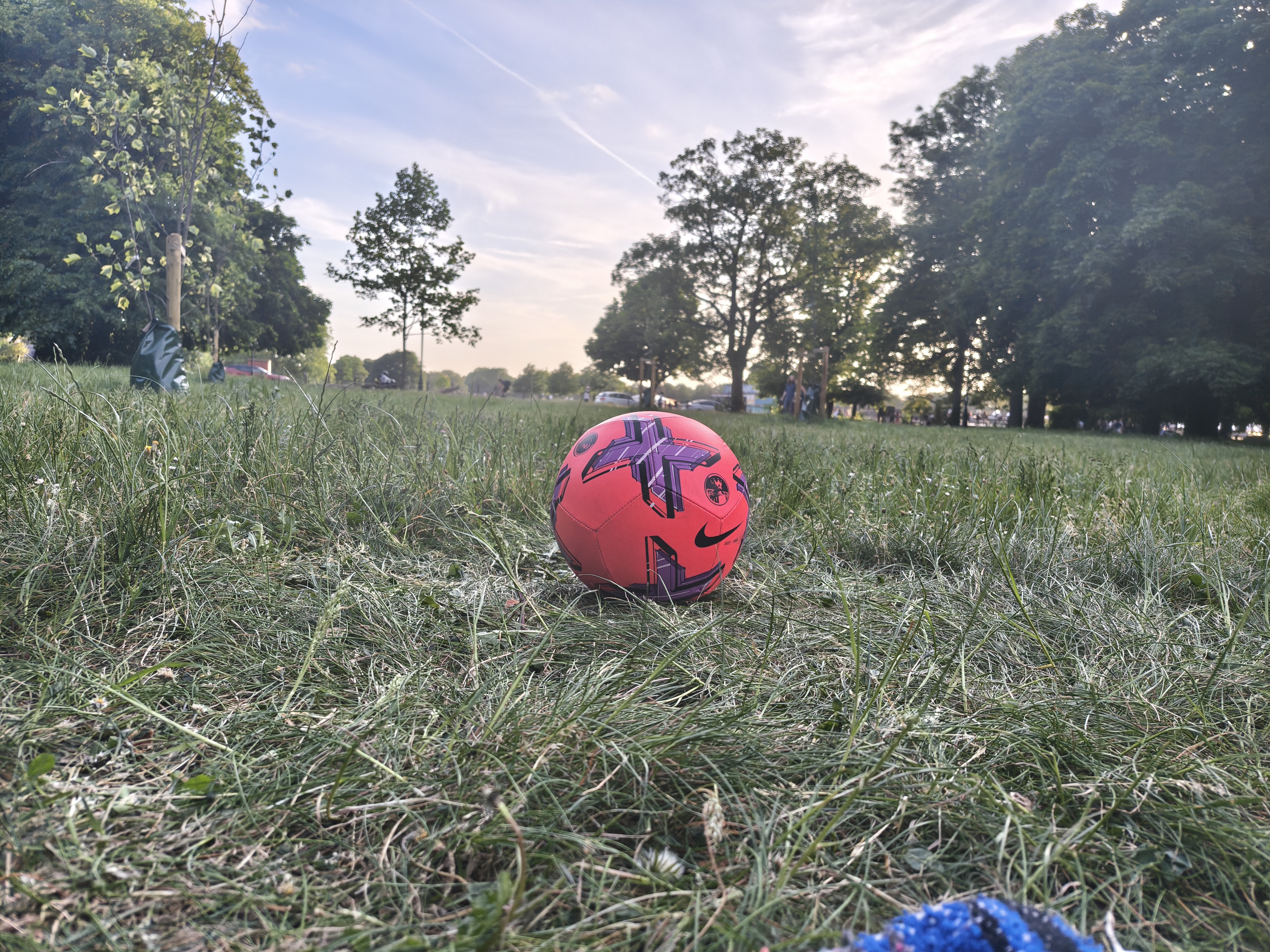Why you can trust TechRadar
We spend hours testing every product or service we review, so you can be sure you’re buying the best. Find out more about how we test.
Motorola Edge 60 Pro two-minute review
When Motorola first started releasing its line of more affordable ‘premium’ Edge smartphones in 2020, it never could have expected that it’d be the last mobile brand to make truly eye-catching flagship phones.
That’s not quite true, of course, but with expensive phones like the Samsung Galaxy S25, iPhone 16, and Xiaomi 15 all offering relatively boring designs that defy their hefty price tags, Moto is one of the few flagbearers whose top-end phones actually feel… well, top-end in 2025.
Moto has released a new generation of Edge phones each year since the debut of the Motorola Edge in 2020, and the Edge 60 Pro is the most advanced model of the current crop (at least until the next Ultra-branded model arrives). And thankfully, almost all of the previous models’ selling points remain valid on the Edge 60 Pro.
Glancing at the phone’s specs list, you might think it’s not an upgraded Edge 50 Pro, but rather a different ‘take’ on it. And to a certain extent, that’s true. The Edge 60 Pro and Edge 50 Pro are very similar phones, with the former bringing as many upgrades as downgrades. The newer model, for instance, has a bigger battery, a higher-res ultra-wide camera, and upgraded speakers, but those positives are counterbalanced by a lower screen refresh rate and slower charging (both wired and wireless).
Some users, then, might consider the Edge 60 Pro to be worse than, or equal to, its predecessor, but the proof is in the pudding, not on the specs sheet.
With the Edge 60 Pro, Motorola has rounded down some unnecessarily high features and balanced those perceived downgrades with upgrades that really matter. I don’t imagine many people need a 144Hz refresh display over 120Hz, for instance, or truly require the extra few minutes that 125W charging saves you over 90W.
The inclusion of Dolby Atmos speakers, meanwhile, tangibly improves the experience of watching movies and TV shows on the Edge 60 Pro, while the jump to another chipset provider results in a useful jump in power. The addition of reverse wired charging, too, is really useful if you’re reliant on other gadgets.
These small-but-important improvements result in a phone that’s strong in all areas, though not the best in any of them, and for the 99% of people who don’t actually need the literal top specs available to them, that’s okay.
The only exception comes in the camera department, which is still a weak point of the Edge series. A few annoying issues abound, but the real problem is that photos taken on the Edge 60 Pro are too devoid of color. They look lifeless and dull, as though the AI scene optimization shrugged and said, “I can’t be bothered”. The phone’s camera performance doesn’t compare to that of any top-end rivals.
That would be a bigger problem if the Edge 60 Pro were hampered by an extreme price tag, but it isn’t. It undercuts pretty much all of the best Android phones by a decent margin, making it a borderline budget alternative that arguably feels fancier.
As sanded-down premium phones, Moto’s Edge devices appeal to those who want to feel like they own a powerful phone but won’t ever put that power to the test. Sure, the Edge 60 Pro won’t win any benchmark battles, but in a year’s time, when even the ultra-pricey Samsung Galaxy S25 Ultra has been transformed into an ugly box, Motorola’s latest flagship will at least look the part. It’s one of the best Motorola phones you can buy today.
Motorola Edge 60 Pro review: price and availability
- Released in April 2025
- Phone sells for £599 (roughly $800, AU$1,250)
- Price matches predecessor
The Motorola Edge 60 Pro was announced alongside a non-Pro version in April 2025, roughly a year on from the release of the previous series, albeit with a different selection of sibling suffixes.
You can pick up the phone for £599 (roughly $800, AU$1,250). Due to precedent, we don’t expect that Moto will release the Edge 60 Pro in the US, but an Australian announcement seems likely later this year, especially with the Edge 60 Fusion already selling in the country.
That price makes the Edge 60 Pro the most expensive non-folding smartphone sold by Motorola, but in the wider smartphone world, it’s on the border of mid-range and premium – which means it undercuts a lot of big-name flagship rivals. The Google Pixel 9, Samsung Galaxy S25, and iPhone 16 all cost more, while the supposedly budget-friendly iPhone 16e retails for the same price.
Motorola Edge 60 Pro review: specs
| Header Cell – Column 0 | Header Cell – Column 1 |
|---|---|
|
Dimensions: |
160.69 x 73.06 x 8.24mm |
|
Weight: |
186g |
|
Screen: |
6.7-inch FHD (1220 x 2712) 120Hz AMOLED |
|
Chipset: |
Mediatek Dimensity 8350 |
|
RAM: |
12GB |
|
Storage: |
512GB |
|
OS: |
Android 15 |
|
Primary camera: |
50MP, f/1.8 |
|
Ultra-wide camera: |
50MP f/2.0 120-degree |
|
Telephoto camera: |
10MP, f/2.0 2x optical |
|
Front camera: |
50MP, f/2.0 |
|
Audio: |
Dolby Atmos stereo speakers |
|
Battery: |
6,000mAh |
|
Charging: |
90W wired, 15W wireless |
|
Colors: |
Dazzling Blue, Sparkling Grape, Shadow |
Motorola Edge 60 Pro review: design
- Premium curved-edge design
- Thin and lightweight
- Pantone-designed blue, khaki or purple
With companies like Samsung having seemingly jettisoned ‘attractive design’ from the list of important smartphone traits this year, I was worried that Motorola might abandon the Edge’s roots and follow suit. Fear not: the Motorola Edge 60 Pro is just as appealing as past entries (largely because it’s a dead ringer for past models).
To discuss the eye-catching part, we’ll have to start at the back: Moto typically offers these mobiles in a range of Pantone-designed hues, and it’s no different this time around. The model you see in the review images is Dazzling Blue, and there’s a greenish-khaki Shadow option too, but the real eye-catcher is Sparkling Grape, a vibrant and commanding purple. Unlike in some previous generations, Moto hasn’t included a literal color swatch on the back of the Edge 60 Pro, so you don’t feel like you’re texting on a walking paint advertisement.
Instead, the back features a slightly raised camera bump that’s incorporated well into the overall design; it’s reminiscent of Oppo Find X phones before they became overdesigned. It doesn’t stick that far from the phone’s body, so you can put the handset flat on a surface without undue wobbling. The phone’s rear is also textured – slightly differently depending on the color option you pick – making it feel more premium than your average Android.
Moving to the sides reveals the Edge 60 Pro’s other premium feature: a curved-edge display (admittedly, the name does give it away). This means that the phone’s screen curves slightly at the edges to become incorporated seamlessly into the sides of the phone without ending at an abrupt angle. While curved edges are divisive, and admittedly are slightly frail and prone to accidental touches, they’re still considered a trait of premium mobiles. As a result, the Edge 60 Pro is much more comfortable to hold in the hand than your average flagship, and it just feels more advanced.
The edges of the phone also feature all the mandatory buttons, plus one extra one. The right edge has a power button – just about within thumb’s reach on my hand – and above it a volume rocker, which I had to stretch to use. But on the left side, high enough up that I couldn’t really reach it, is a new addition: the AI Key.
Pressing and holding this button brings up Motorola’s AI assistant, while double-pressing it either opens a note-taking function or quickly summarizes your notifications – all of these require a separate Motorola account. If you’ve no interest in AI features like this, you can turn them off in the settings menu.
Let’s briefly continue our tour around the Edge 60 Pro: the bottom edge has its USB-C charging port and the SIM card slot. There’s no 3.5mm jack for wired audio, like in past generations. And that’s that in terms of design – except for the display, which we have a whole section about.
The total dimensions of the phone are 160.69 x 73.06 x 8.24mm, and it weighs 186g, so it’s on the lighter side of things.
Moto is also making a song and dance about the Edge 60 Pro’s protections. It has IP69 certification, indicating that it’s safe from dust ingress and high-pressure beams of water, plus the military MIL-STD-810H accreditation, which means it’s safe from shocks, high and low temperatures, high altitudes, and strong vibrations. We usually only see this kind of certification in rugged phones, but a growing number of consumer ones have them too – and it’s nice to know that your handset is protected from the unexpected.
Motorola Edge 60 Pro review: display
- 6.7 inches, 2712 x 1220 resolution
- 120Hz refresh rate and 4500-nit max brightness
- Various filters and modes to tweak
The Motorola Edge 60 Pro’s screen is 6.7-inches diagonally, a size Edge fans will be used to, and that’s not the only spec that the 60 Pro has in common with its predecessors: the resolution is once again 2712 x 1220, or FHD+, and the 20:9 aspect ratio makes the screen feel long and thin.
We can’t knock Motorola for a lack of design upgrades year-on-year, but some tech fans might be upset that the refresh rate has seen a downgrade from the Edge 50 Pro: it’s now 120Hz. But that’s matched by a massive brightness increase, of over double, to a new high of 4500 nits: suffice to say this is a phone that’s easy to use when you’re outdoors in the sun.
The screen is broken up by a pretty minimal punch-hole cut-out for the front-facing camera at the top. It has an embedded fingerprint scanner which… worked when it wanted to, let’s put it that way.
Motorola has stuffed quite a few design features into the Edge 60 Pro’s display, including support for HDR10+ and DCI-P3 color space. There are also filters to reduce the amount of blue light coming from the display, which may placate people who use blue light filters to help them sleep (despite the scientific evidence that your phone’s blue light doesn’t affect sleep).
Pantone also shows its face for some display tweakery, with Moto’s listing for the Edge 60 Pro also mentioning “Pantone Validated Colour” and “Pantone Skintone Validated”, which suggests the color company had a hand in optimizing the screen.
Good job, too, because the Edge 60 Pro is pleasant to look at while watching movies and playing games, with nice contrast and vibrant colors.
Motorola Edge 60 Pro review: software
- Android 15 with four years of updates
- Customization options galore
- Moto AI useful for small tasks, not big ones
The Motorola Edge 60 Pro comes with Android 15 as its default software. This is stock Android, ostensibly how Google designed it, but with every new generation, Moto adds more and more tweaks that make it feel distinct from Pixel or Nokia phones.
I’ve already discussed arguably the biggest software change – the AI key and Moto AI in general, which the brand seems to be presenting as something you’ll opt to use over Google Assistant for various tasks and needs.
Moto AI is at its best when you’re using it for little tasks around your phone: you can ask it to take notes, set an update reminder, or create a new background for your device. But like other AI chatbots like ChatGPT, if you start to ask it questions, it provides you with the usual factually inaccurate (and oftentimes totally irrelevant) gibberish that you love to mock.
Some of the features that Moto is touting most simply don’t make sense – unless you’ve received an absolute deluge of messages since you last checked your phone, it takes longer to use Moto AI’s notification summary tool than simply to check your messages. There’s also a function that creates a bespoke playlist based on your mood, but it only supports Amazon Music, so if you use Spotify or Tidal, you’re out of luck.
What’s more, every time I used the AI Key, the pop-up appeared with my last search or command, which I’d need to backspace from before starting my new task. I found it pretty frustrating.
Beyond its AI, the Edge 60 Pro retains Moto’s suite of personalization features, from the big things like background, font, and color scheme to the shape of icons and the animation that appears when you use the fingerprint unlock.
You can now also generate wallpapers based on your own prompt or a photo from your gallery. I sent this feature a photo of a cat, and it returned some patterned decals that looked like a marbled chocolate cake. Thanks, but I think I’ll just use the photo of the cat as my background. The point being: some of the AI’s creations were very tangential from the original photo, but I appreciate that none of them resembled the phony tripe you usually get from AI image generators, which is definitely a plus.
Motorola has committed four years of software updates to the Edge 60 Pro. It’s a perfectly acceptable amount of time that’ll future-proof your phone, though it falls just shy of being an industry-leading figure.
Motorola Edge 60 Pro review: cameras
- 50MP main, 50MP ultra-wide and 10MP telephoto cameras
- 50MP front-facing
- Pictures look dull and colorless
- Offers the standard range of camera modes
There are three cameras on the back of the Moto Edge 60 Pro: a 50MP f/1.8 main snapper, a 50MP f/2.0 ultra-wide one with a 120-degree lens, and a 10MP f/2.0 telephoto camera which supports 3x optical zoom.
On paper, that seems like a solid range of snappers, giving you a range of ways to take pictures, whether you want to zoom in from a distance or get yourself nice and close (the ultra-wide snapper also supports a macro mode). But Moto has yet to put out a killer camera phone, and the Edge 60 Pro doesn’t change that streak.
The main issue, which certainly isn’t new for Moto phones, is that pictures are just a little more dull and desaturated than they’d be on any other phone. While many brands pride themselves on the vibrancy of snaps you can take with their phone cameras, the pictures I took on the Edge simply weren’t social media-worthy due to how lifeless they look.
It’s a shame, because technically, the photos taken aren’t terrible – I was really fond of using the telephoto lens, for instance, as its depth of field was exquisite, and thanks to the high-res snappers, photos have lots of detail. But while some photos could be saved by dropping them into Photoshop, this shouldn’t be a necessary step for smartphone photographs to look worthy.
That’s not my only issue with the Edge 60 Pro’s cameras, though it’s the only one that can’t be deactivated. Firstly, the background bokeh blur on Portrait shots is intense – you can change this, but I only noticed after taking a few shots, so make sure to tweak it yourself. But the other biggie is macro mode, which by default turns on when you put the phone near a close-up subject.
When this mode turns on, it jumps over to the ultra-wide lens, which is lower positionally than the other two (when you’re holding the phone horizontally to take a shot). This often meant that the subject was in a different spot of the frame, or not in frame, causing the camera to decide that I was no longer trying to take a macro snap, and jump back to the main camera, whereupon it’d see the subject again. Rinse and repeat, you can see how this goes.
The camera app features most of the photography and video modes that you’re used to seeing on an Android phone, like slow-mo video, night vision shots, and tilt-shift photography. Video recording goes up to 4K at 30fps or 1080p at 60fps.
The selfie camera is a 50MP f/2.0 snapper, and it uses an ultra-wide lens so that you can take wider group shots if you need, though it defaults to the one-person view. These pictures suffer from the aforementioned issues, specifically Portrait absolutely obliterating the background, and the color tuning being lackluster – in the examples below, there’s an odd green hue to several of the images.
Motorola Edge 60 Pro camera samples
Motorola Edge 60 Pro review: performance and audio
- Uses the Dimensity 8350 chipset
- 12GB RAM and 512GB Storage
- Dolby Atmos-tuned stereo speakers
The Motorola Edge 60 Pro marks a shift for Moto in that it’s moved from the dominant chipset maker Qualcomm to its underdog rival Mediatek.
The phone uses the Mediatek Dimensity 8350 chipset, a fairly powerful mid-range Android chip that we also saw in the Oppo Reno 13 Pro. Like in that contemporary handset, it provides good amounts of power, enough that most users won’t notice a difference between it and true top-end ones for most ordinary tasks.
A Geekbench 5 benchmark test on the Edge 60 Pro returned a multi-core score of 4,504, which is a solid upgrade on the roughly 3,000 score we saw on the Edge 50 Pro, and even better than the Reno 13’s 4,042.
The sole configuration on sale offers 12GB RAM and 512GB storage, which is generous: it means you’ve got loads of space to store years of photos and countless apps, and the RAM ensures the handset feels fast to use. There’s also RAM boost, which lets you sacrifice some storage space for a speed increase; a feature that has niche appeal but will be useful to certain users.
Audio-wise, Moto has long since binned off the 3.55mm jack in its Edge phones. However, you’re getting Dolby Atmos-tuned stereo speakers instead, which isn’t quite as good as wired headphones, but it’ll do.
Motorola Edge 60 Pro review: battery life
- Boosted 6,000mAh battery
- 90W wired charging, 15W wireless
- Reverse wired charging is new
Motorola has packed the Edge 60 Pro with a massive 6,000mAh battery, which is markedly bigger than the cell in its predecessor, though that upgrade is counterbalanced – on paper, at least – by a decrease in charging speed.
A big power pack like this ensures that the Edge 60 Pro can breeze through a day of use without running out of power, which isn’t a guarantee with big-screen phones these days. I also found that the Edge 60 Pro could withstand lengthy gaming sessions without draining too much power.
However, the amount of battery drain ensured that this isn’t a two-day phone; it’ll need daily recharges.
The charging speed sits at 90W, which, while technically a downgrade from the 125W powering on the Edge 50 Pro, is still an impressive figure. The difference between the two can be measured in mere minutes of charging speed, and I think most people won’t even notice the downgrade.
Motorola estimates that the charging time for the Edge 60 Pro is 40 minutes; however, to get this speed, it recommends that you use a sold-separately charger, which I couldn’t actually find on its website (in the box, you get a USB-C to USB-C cable but no mains plug). Mind you, even when using a third-party fast charger, my charging times weren’t that much longer.
Like any good premium phone, the Edge 60 Pro also offers wireless charging, although it too has seen a speed downgrade versus the last-gen model. It can support wireless charging at 15W and, while there’s no longer support for reverse wireless charging, the Edge 60 Pro does offer reverse wired charging, which lets you use it as a little power bank to charge other gadgets.
Motorola Edge 60 Pro review: value
Throughout this review, I’ve been mentally referring to the Motorola Edge 60 Pro as a premium phone, which is both correct and wrong.
It’s a correct designation in that the specs are all there, but wrong in that the phone doesn’t actually cost quite as much as a Galaxy, iPhone, or Pixel.
The bottom line: the Edge 60 Pro is a great-value phone if you want a top-end mobile, because you’re paying a bit less for mostly-similar specs. Sure, its cameras will leave you wanting, but in almost every other department, the Edge 60 Pro is a winner.
Should you buy the Motorola Edge 60 Pro?
|
Attributes |
Notes |
Rating |
|---|---|---|
|
Value |
You’re basically getting a premium smartphone for a lower price, which sounds good to me! |
4 / 5 |
|
Design |
The phone feels and looks premium, and it’s well-protected with military-grade accreditation. |
4 / 5 |
|
Display |
The Edge 60 Pro has a high-res screen with a top max brightness and useful extra features. |
4 / 5 |
|
Software |
It’s a clean software with customization options and a long shelf life, even if Moto is relying too much on AI as a big new feature. |
3.5 / 5 |
|
Camera |
Photos look dull and there are one or two other issues with the cameras that lose it points. |
3 / 5 |
|
Performance |
The chipset suits most tasks and there’s lots of storage and RAM to go around. |
4 / 5 |
|
Battery |
It’s fast to charge and has a decently-sized battery, though there are some downgrades here. |
4 / 5 |
Buy it if…
Don’t buy it if…
Motorola Edge 60 Pro review: Also consider
Still not sold on the Motorola Edge 60 Pro? Here are some other comparable smartphones you should consider looking at instead:
| Header Cell – Column 0 |
Motorola Edge 60 Pro |
iPhone 16e |
Xiaomi Poco F7 Ultra |
Motorola Edge 50 Pro |
|---|---|---|---|---|
|
Starting price (at launch): |
£599 (roughly $800, AU$1,250) |
$599 / £599 / AU$999 |
£649 (roughly $900, AU$1,400) |
£599.99 / AU$999 (roughly $800) |
|
Dimensions: |
160.69 x 73.06 x 8.24mm |
146.7 x 71.5 x 7.8mm |
160.3 x 75 x 8.4mm |
161.2 x 72.4 x 8.2mm |
|
Weight: |
186g |
167g |
212g |
186g |
|
OS (at launch): |
Android 15 |
iOS 18 |
Android 15, HyperOS 2 |
Android 14 |
|
Screen Size: |
6.7-inch |
6.1-inch |
6.67-inch |
6.7-inch |
|
Resolution: |
2712 x 1220 |
2532 x 1170 |
1440 x 3200 |
1220 x 2712 |
|
CPU: |
Mediatek Dimensity 8350 |
Apple A18 |
Qualcomm Snapdragon 8 Elite |
Qualcomm Snapdragon 7 Gen 3 |
|
RAM: |
12GB |
8GB |
12GB / 16GB |
up to 12GB |
|
Storage (from): |
512GB |
128GB / 256GB / 512GB |
256GB / 512GB |
256GB / 512GB |
|
Battery: |
6,000mAh |
4,005mAh |
5,300mAh |
4,500mAh |
|
Rear Cameras: |
50MP main, 10MP telephoto. 50MP ultra-wide |
48MP main |
50MP main, 32MP ultra-wide |
50MP main, 10MP telephoto, 13MP ultra-wide |
|
Front camera: |
50MP |
12MP |
32MP |
50MP |
How I tested the Motorola Edge 60 Pro
- Review test period = 2 weeks
- Testing included = Everyday usage, including web browsing, social media, photography, video calling, gaming, streaming video, music playback
- Tools used = Geekbench 6, Geekbench ML, GFXBench, native Android stats
I tested the Motorola Edge 60 Pro for two weeks in order to write this review.
In that time, I used it as my normal phone, which involved socializing, listening to music, taking pictures, and playing games, as well as lots of other normal tasks.
I also did some ‘lab’ tests with the phone, as you’ll have read about in the performance section of this review, in order to get a more objective understanding of its power.
I’ve been reviewing smartphones for TechRadar for over six years now, and even reviewed the original Moto Edge models. So, I’m well-versed in the brand and its various handsets.
Read more about how we test
First reviewed May 2025
Read the full article here



















